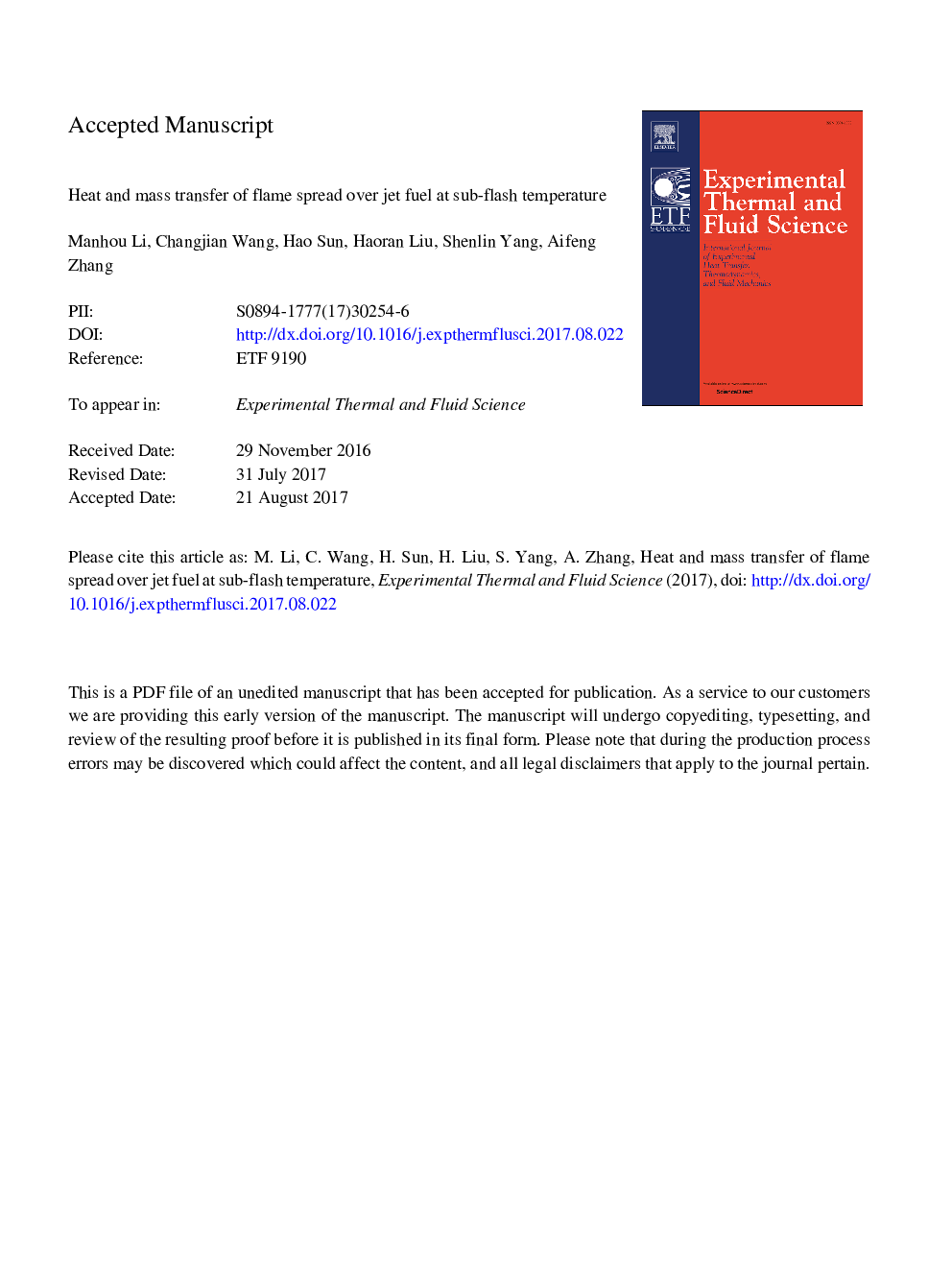| کد مقاله | کد نشریه | سال انتشار | مقاله انگلیسی | نسخه تمام متن |
|---|---|---|---|---|
| 4992474 | 1457387 | 2017 | 35 صفحه PDF | دانلود رایگان |
عنوان انگلیسی مقاله ISI
Heat and mass transfer of flame spread over jet fuel at sub-flash temperature
ترجمه فارسی عنوان
انتقال گرما و جرم شعله بر جت سوخت در دمای زیر فلش پخش می شود
دانلود مقاله + سفارش ترجمه
دانلود مقاله ISI انگلیسی
رایگان برای ایرانیان
کلمات کلیدی
شعله پخش می شود سوخت موشک، انتقال حرارت و جرم، جریان کنونی زیرسطحی،
ترجمه چکیده
انتشار شعله بر روی سطح سوخت مایع یک مشکل پیچیده از تعاملات متصل است، از جمله انتقال حرارت، انتقال جرم و فرآیندهای هیدرودینامیکی. بر اساس برخی آزمایش های آزمایشی آزمایشی آزمایشگاهی، مکانیزم انتقال حرارت و جرم شعله در سطح سوخت جت در دمای زیر فلش گسترش یافته است. نتایج نشان می دهد که جریان کنسرو مایع فاز زیتون شکل که نزدیک به سطح استخر است، ظاهرا در طی فرایند پخش شعله فلزی زیر فلش شکل می گیرد. جریان انتقال جریان زیرزمینی می تواند به دو منطقه تقسیم شود: یک لایه نازک از جریان رانشی سطحی و یک ناحیه گرداب حرارتی ضخیم ناشی از اثرات اتصال کشش سطحی و نیروی چسبناک. علاوه بر این، یک تخمین نظری پیش بینی می کند که سرعت جریان کناری زیر سطح به طور قابل توجهی بزرگتر از داده های تجربی است و چندین دلیل احتمالی برای تفسیر این تفاوت پیشنهاد شده است. علاوه بر این، مقدار انتقال حرارت که در شعله بر روی سوخت مایع گسترش می یابد، با افزایش دمای استخر کاهش می یابد، در حالی که سرعت شعله با افزایش دمای اولیه افزایش می یابد. انتقال حرارت حرارت مایع به فاز انتقال حرارت 88٪ در جریان پخش شعله کمک می کند.
موضوعات مرتبط
مهندسی و علوم پایه
مهندسی شیمی
جریان سیال و فرایندهای انتقال
چکیده انگلیسی
Flame propagation over the surface of a liquid fuel is a complicated problem of coupled interactions, including heat transfer, mass transfer, and hydrodynamic processes. Based on some tentative laboratory-scale experiments, the heat and mass transfer mechanisms of flame spread over jet fuel surface at sub-flash temperature are investigated. Results show that an olive-shaped liquid-phase convection flow, which is close to the pool surface, apparently forms during the sub-flash flame spread process. The subsurface convection flow could be separated into two regions: a thin layer of surface tension-driven flow and a thick thermal vortex zone induced by the coupling effects of surface tension and viscous force. Moreover, a theoretical deduction predicts that the velocities of subsurface convection flow are considerably larger than the experimental data, and several probable reasons are proposed to interpret this difference. Furthermore, the magnitude of heat transfer involving in flame spread over liquid fuel decreases as the pool temperature increases, whereas the velocity of flame spread increases with the initial fuel temperature. The liquid-phase convective heat transfer contributes 88% heat flux in the process of flame spreading.
ناشر
Database: Elsevier - ScienceDirect (ساینس دایرکت)
Journal: Experimental Thermal and Fluid Science - Volume 89, December 2017, Pages 276-283
Journal: Experimental Thermal and Fluid Science - Volume 89, December 2017, Pages 276-283
نویسندگان
Manhou Li, Changjian Wang, Hao Sun, Haoran Liu, Shenlin Yang, Aifeng Zhang,
